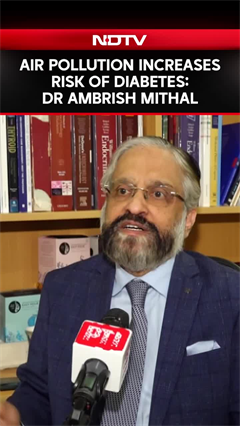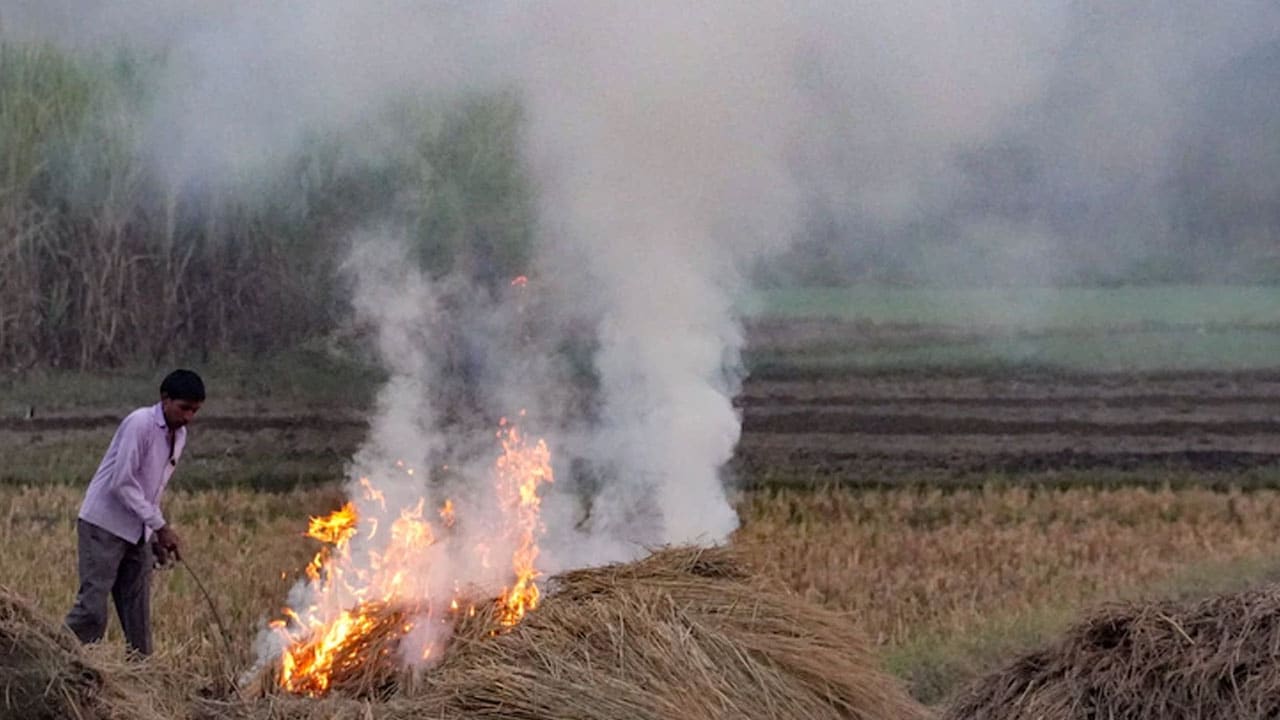- Home/
- Toxic Air, Tiny Lungs: Why Children Face The Greatest Risk From PM2.5 Exposure
Toxic Air, Tiny Lungs: Why Children Face The Greatest Risk From PM2.5 Exposure

Highlights
- Children inhale nearly 40% of PM2.5 deep into their lungs, causing severe health issues
- Winter air traps pollutants, worsening respiratory problems in children and vulnerable groups
- PM10 affects upper airways, PM2.5 causes lower airway inflammation, PM0.1 impacts immunity
Children are suffering the most as the air we breathe worsens, becoming toxic. Experts are witnessing an alarming surge in severe eye infections and breathing problems. A recent analysis by the Centre for Research on Energy and Clean Air (CREA) revealed that nearly 40% of PM2.5 inhaled by children reaches the deepest part of their lungs, causing major health issues.
The analysis, published in the Ecotoxicology and Environmental Safety journal, further noted that even infants are struggling, with about 30% of fine particles reaching the pulmonary region as compared to 1% in the case of PM10.
Also Read | Most Osteoporosis Cases In Men Remain Undiagnosed, Experts Reveal Why
Experts Reveal What Exactly Is Happening
Social media is abuzz with claims that this year, the pollution is the worst, with constant heaviness in the chest and other alarming issues.
Air quality deteriorates in many cities to alarming levels with the onset of the winter season, and this seasonal change has a direct and immediate impact on respiratory health, especially in children, the elderly, and individuals with asthma or chronic obstructive pulmonary disease (COPD).
"The cooler air traps pollutants closer to the ground, while smoke from firecrackers, vehicles, and crop burning increases particulate matter. These fine particles, when inhaled, penetrate deep into the lungs, triggering inflammation, cough, breathlessness, and in severe cases, acute asthma or COPD exacerbations," Dr Arup Halder, Pulmonologist, CK Birla Hospitals - CMRI, Kolkata, told NDTV.
Also Read | Could H5N5 Strain Of Bird Flu Be The Next Pandemic? Experts Answer
Decoding Particulate Matter Types
Particulate matter (PM) is of three major types - PM10 (coarse particles), PM2.5 (fine particles), and PM0.1 (ultrafine particles), Dr Shishir Bhatnagar, Senior Consultant - Paediatrician and Neonatologist at Cloudnine Group of Hospitals, told NDTV. He further explained how these particles affect us.
- PM 10 gets restricted into the nose and upper airways, thereby creating either an allergic reaction in the nose or in the upper airways, causing sneezing, coughing, and nasal allergies.
- PM 2.5 micrometres enter the upper airways, go into the lower airways and go past in the bronchi and bronchioles. They are the ones which are responsible for causing the inflammation in the lower airways, which produces symptoms of cough, wheezing, difficulty in breathing, and chest tightness.
- The particle size less than 1 micrometre and smaller than this are the ones which can translocate into the circulation and into the cells; they tend to affect the immune system, the developing immune system in a very small newborn and even in pregnant ladies.
Air Pollution Causes Immunological Problems
"These (ultrafine) particles are the ones responsible for creating immunological problems, can create problems of immunity, can also cause a neurological development problem in small newborn children," Dr Bhatnagar said.
These particles are produced by the soot, burning of the charcoal, burning of the wood, and more. Furnaces produce chemicals, like sulfuric acid and nitric oxide. And also spores and fungi, present indoors.
Also Read | Spice Commonly Found In Indian Kitchens Can Fight Fat, Study Reveals
How Our Children Are Suffering The Most
Children are particularly vulnerable as their lungs are still developing and they breathe faster than adults, absorbing more pollutants relative to their body size.
"The coughing, wheezing, difficulty in breathing is much more, and the inflammation is much more in children, which will require bronchodilators," Dr Bhatnagar said.
The experts also said that you will not be able to restrict the children inside for a long time. "For an adult, I can say stay indoors, but for children it is very difficult," Dr Bhatnagar added.
"Significant Surge In Severe Eye Irritation"
"With the current levels of air pollution rising, we're witnessing a significant surge in patients with severe eye irritation, burning, redness and even conjunctivitis in some cases," Dr Mandeep Singh Basu, Director, Dr Basu Eye Care Centre, told NDTV.
Air pollution can also cause corneal damage and even accelerate serious conditions like glaucoma, immature cataracts, and diabetic retinopathy by elevating oxidative stress and intraocular pressure. Pollution directly disrupts the tear film and irritates the ocular surface, which can lead to conditions such as dry eyes.
"Ignoring these symptoms can cause prolonged and irreversible harm. Amid this situation, we highly recommend protective measures for our patients to protect their eyes with herbal eye drops, rinse with clean water and avoid exposure during peak hours," Dr Basu added.
Preventive Steps Make a Big Difference
Dr Halder suggested that on days when the Air Quality Index (AQI) is poor, it's best to limit outdoor activities, especially early mornings and late evenings.
"Using well-fitted N95 masks, air purifiers at home, and keeping windows closed during peak hours can reduce exposure. Staying hydrated, maintaining good nutrition, and adhering to prescribed inhalers or medications are essential."
In India, the burden is especially high, but legal rulings, stricter standards, and everyday protective habits can reduce the damage.
also read
Latest Stories
- Edited by Srishti Singh Sisodia | Thursday November 20, 2025
Children are vulnerable as their lungs are still developing and they breathe faster than adults, absorbing more pollutants relative to their body size.
- Written by Aastha Ahuja | Thursday November 20, 2025 , New Delhi
The air quality index (AQI) is a public health tool designed to communicate air pollution levels or the quality of air in simple terms.
- Press Trust of India | Thursday November 20, 2025 , New Delhi
Health experts have flagged that the toxic air poses heightened risks to expectant mothers and their babies.
- Reported by Ishika Verma | Wednesday November 19, 2025 , New Delhi
After weeks of parents, students and residents taking to the streets over Delhi's choking air, the city government on Wednesday finally opened its doors to those leading the protest.
- Written by Mohit Bhardwaj | Wednesday November 19, 2025
Here are 5 practical tips to reduce air pollution exposure while driving, as Delhi-NCRs air quality deteriorates, with AQI levels hitting severe marks despite failed artificial rain efforts.
................................ Advertisement ................................
Latest Videos
Opinion
Blog | Well Done, Delhi. You've Turned Lung Sacrifice Into A Badge Of HonourSaikat Kumar Bose
Monday November 10, 2025Till some years back, Delhiites would ask angry questions to those in power about the capitals annual tryst with toxic air. This has changed. Those in the driving seat dont see the need to answer now.
Opinion | Why Indians Have Just Given Up On Air Pollution CrisisTanushree Ganguly
Friday December 20, 2024While some may argue that people in Delhi are now more aware of air pollution than they were a decade back, my rebuttal would be that awareness does not mean that people are concerned.
Opinion | You Must Outrage Over Filthy Air More Than Once A YearJyoti Pande Lavakare
Tuesday December 10, 2024Delhi welcomed us with monsoon rains and mangos. We were home. Fast forward a couple of years, in the winter of 2012, I found myself in denial about something other parents, mostly expats, were calling toxic air.
Opinion | Delhi's Air Pollution Situation Is Like A Bad MarriageNishtha Gautam
Friday November 22, 2024On a good day, such as today, the AQI reading in Delhi is 407. We are jubilant at the sickly sunshine trickling through the slightly dissipated smog. At least its not 1600.
दिवाली... पराली... सियासी जुगाली!Ashwini kumar
Monday November 18, 2024दिल्ली-एनसीआर में प्रदूषण का समाधान तो आज तक मिला नहीं. हर साल चिंतित होकर हम-आप सांसों की तकलीफ के साथ-साथ दिल और ब्लड प्रेशर के मरीज भी क्यों बनें?


















